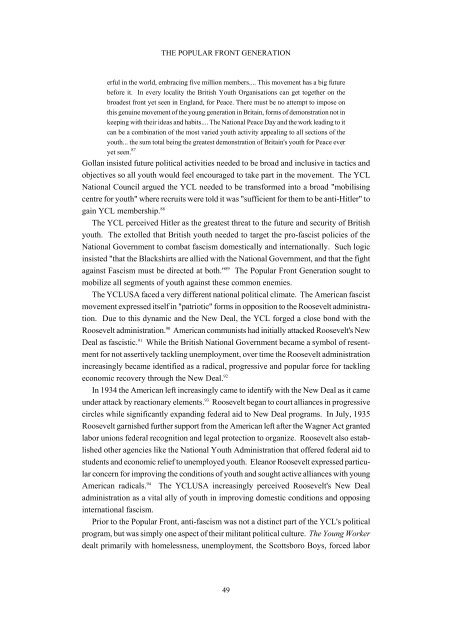Joel A Lewis Youth Against Fascism.pdf
Joel A Lewis Youth Against Fascism.pdf
Joel A Lewis Youth Against Fascism.pdf
Create successful ePaper yourself
Turn your PDF publications into a flip-book with our unique Google optimized e-Paper software.
THE POPULAR FRONT GENERATION<br />
erful in the world, embracing five million members.... This movement has a big future<br />
before it. In every locality the British <strong>Youth</strong> Organisations can get together on the<br />
broadest front yet seen in England, for Peace. There must be no attempt to impose on<br />
this genuine movement of the young generation in Britain, forms of demonstration not in<br />
keeping with their ideas and habits.... The National Peace Day and the work leading to it<br />
can be a combination of the most varied youth activity appealing to all sections of the<br />
youth... the sum total being the greatest demonstration of Britain's youth for Peace ever<br />
yet seen. 87<br />
Gollan insisted future political activities needed to be broad and inclusive in tactics and<br />
objectives so all youth would feel encouraged to take part in the movement. The YCL<br />
National Council argued the YCL needed to be transformed into a broad "mobilising<br />
centre for youth" where recruits were told it was "sufficient for them to be anti-Hitler" to<br />
gain YCL membership. 88<br />
The YCL perceived Hitler as the greatest threat to the future and security of British<br />
youth. The extolled that British youth needed to target the pro-fascist policies of the<br />
National Government to combat fascism domestically and internationally. Such logic<br />
insisted "that the Blackshirts are allied with the National Government, and that the fight<br />
against <strong>Fascism</strong> must be directed at both." 89 The Popular Front Generation sought to<br />
mobilize all segments of youth against these common enemies.<br />
The YCLUSA faced a very different national political climate. The American fascist<br />
movement expressed itself in "patriotic" forms in opposition to the Roosevelt administration.<br />
Due to this dynamic and the New Deal, the YCL forged a close bond with the<br />
Roosevelt administration. 90 American communists had initially attacked Roosevelt's New<br />
Deal as fascistic. 91 While the British National Government became a symbol of resentment<br />
for not assertively tackling unemployment, over time the Roosevelt administration<br />
increasingly became identified as a radical, progressive and popular force for tackling<br />
economic recovery through the New Deal. 92<br />
In 1934 the American left increasingly came to identify with the New Deal as it came<br />
under attack by reactionary elements. 93 Roosevelt began to court alliances in progressive<br />
circles while significantly expanding federal aid to New Deal programs. In July, 1935<br />
Roosevelt garnished further support from the American left after the Wagner Act granted<br />
labor unions federal recognition and legal protection to organize. Roosevelt also established<br />
other agencies like the National <strong>Youth</strong> Administration that offered federal aid to<br />
students and economic relief to unemployed youth. Eleanor Roosevelt expressed particular<br />
concern for improving the conditions of youth and sought active alliances with young<br />
American radicals. 94 The YCLUSA increasingly perceived Roosevelt's New Deal<br />
administration as a vital ally of youth in improving domestic conditions and opposing<br />
international fascism.<br />
Prior to the Popular Front, anti-fascism was not a distinct part of the YCL's political<br />
program, but was simply one aspect of their militant political culture. The Young Worker<br />
dealt primarily with homelessness, unemployment, the Scottsboro Boys, forced labor<br />
49

















